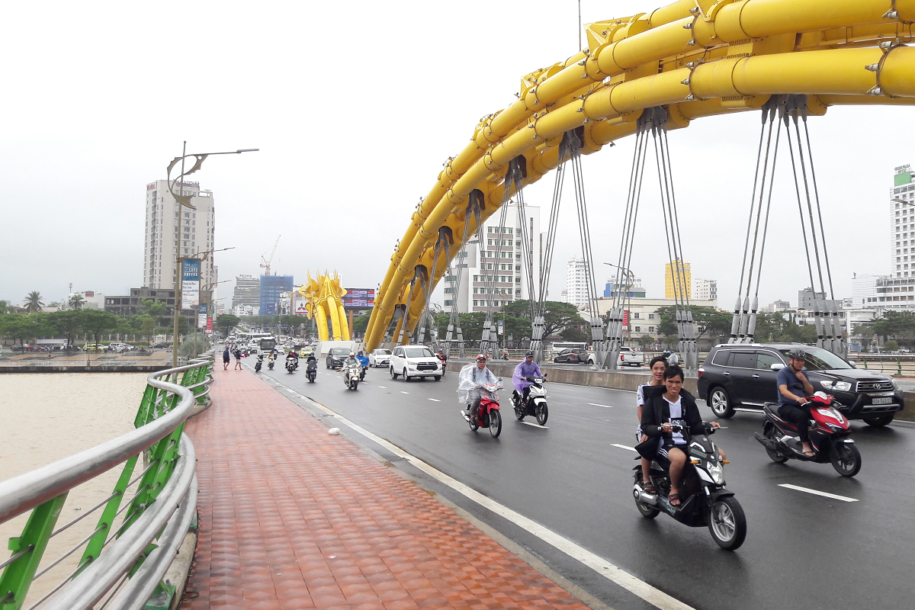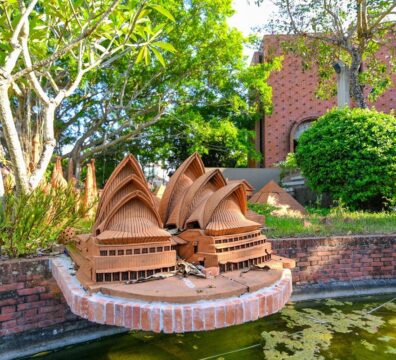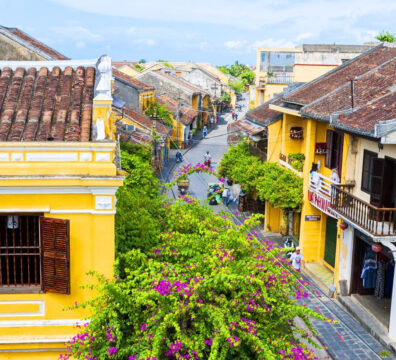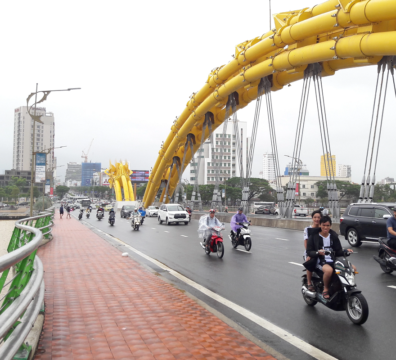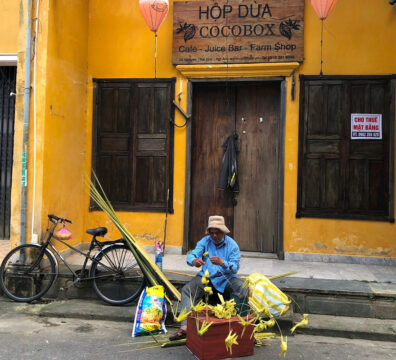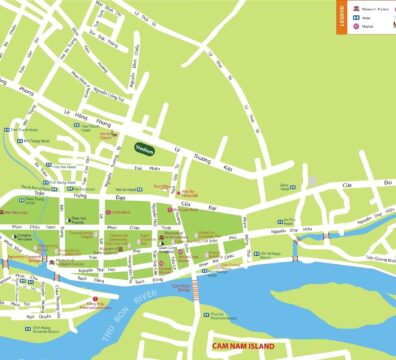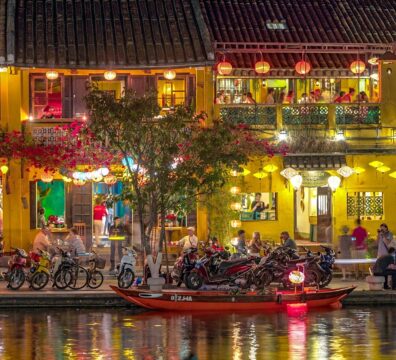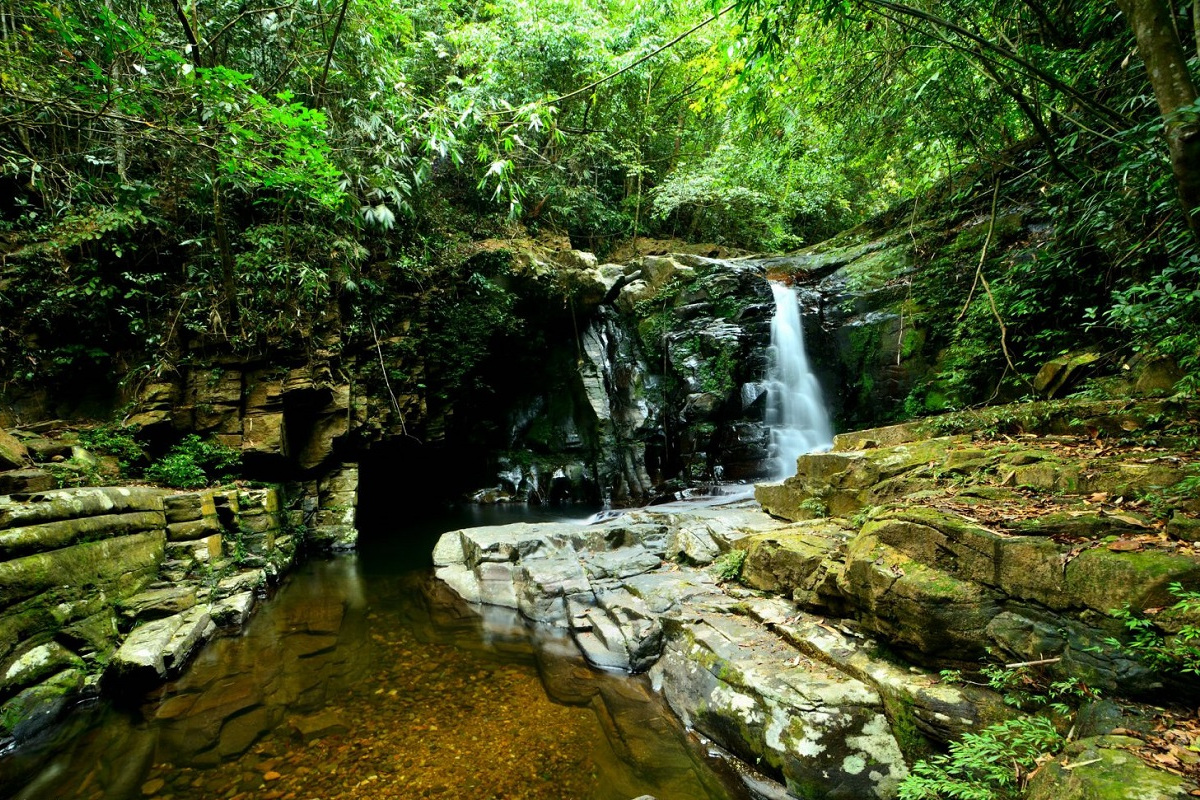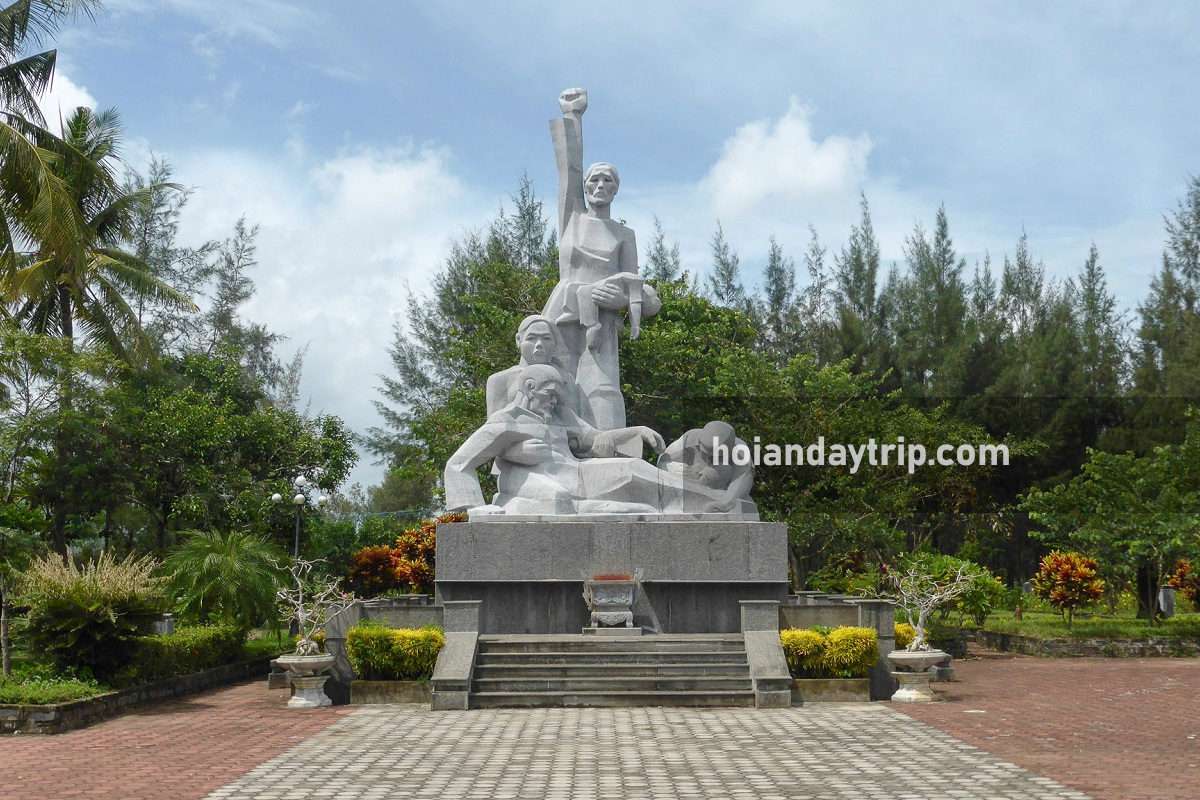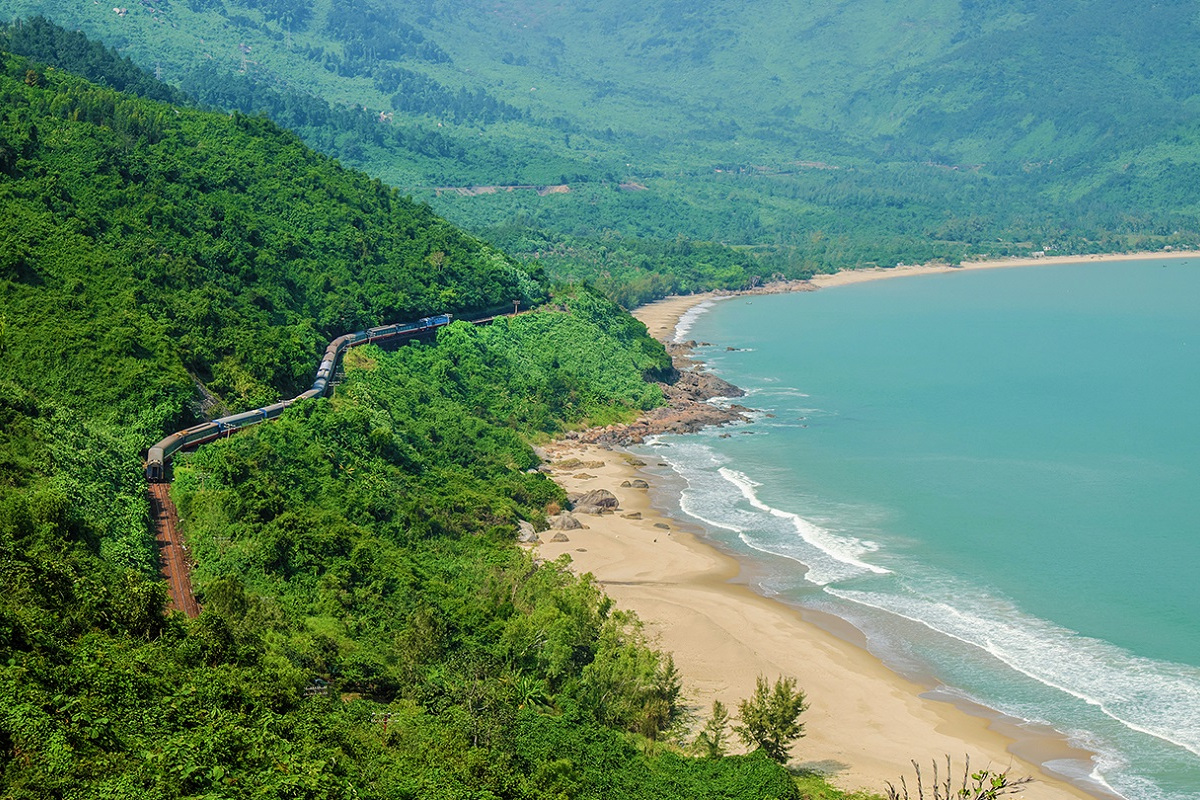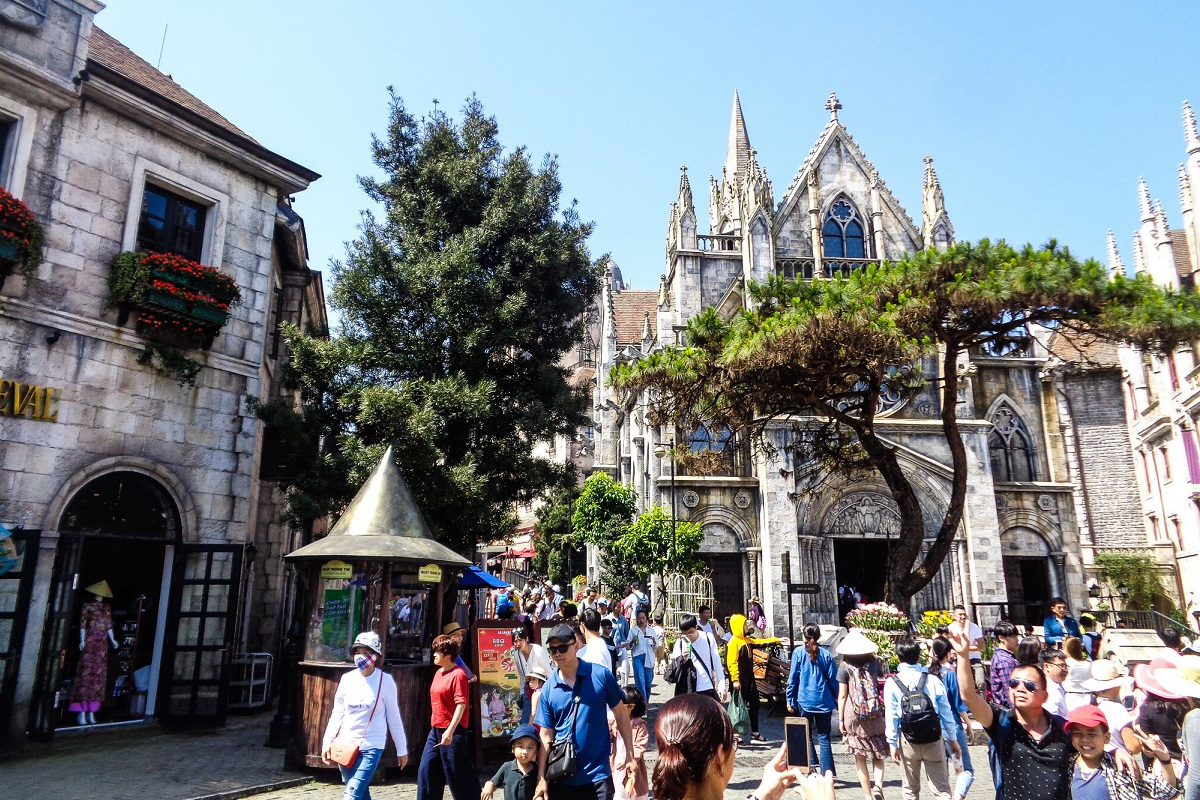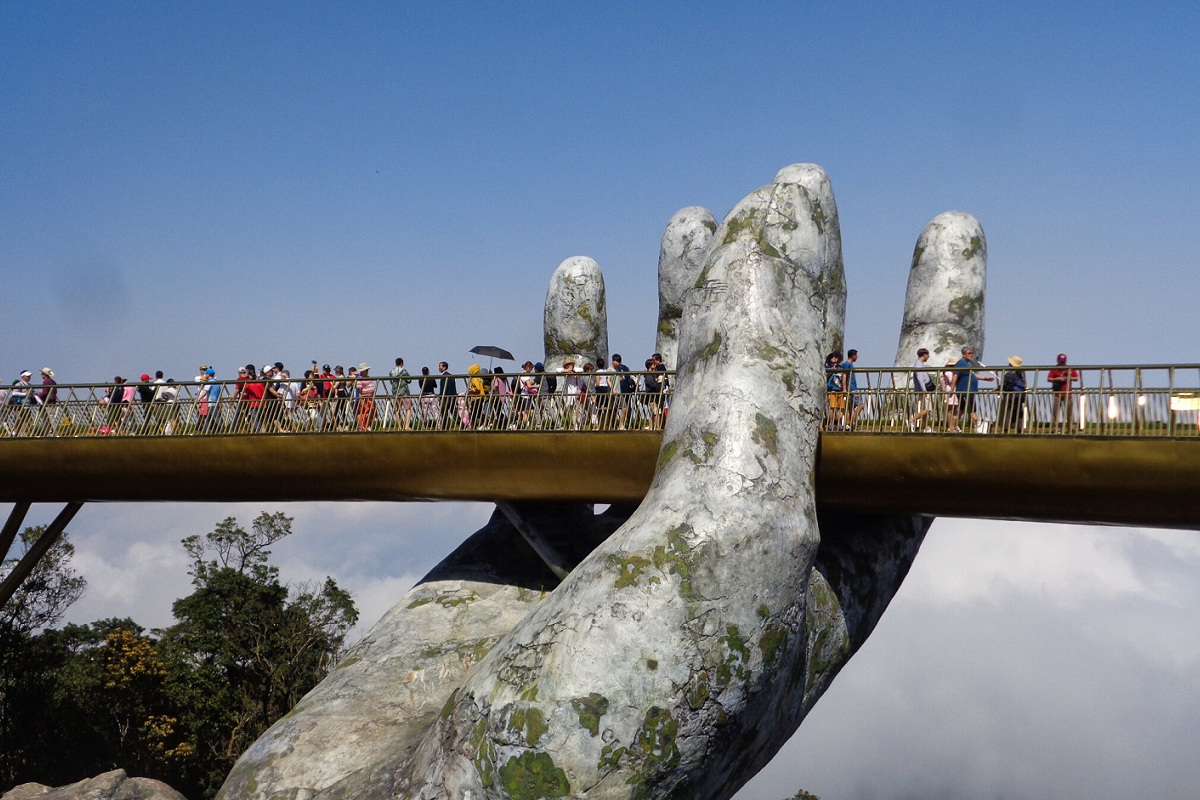Da Nang is the neighbouring city of Hoi An. It’s the capital of Central Vietnam and has the most important (busiest) transport hubs of the region, such as airport, train station, bus station, cruise port. No doubt, it’s the gateway of itself and sister town Hoi An with the rest of the country and the world. If traveling by air from abroad, travelers definitely land in Da Nang first and then have a transfer to Hoi An if they like to visit it. And vice versa, it’s needed to return to Da Nang to fly to the next destination or home. For those who explore Vietnam from south to north by train or most clearly, go to Hue, they also need to reach the train station there. Da Nang’s railway station is the only choice. This article outlines all the ways to get from Hoi An to Da Nang, to help travelers quicker find out the best transport for themselves.
Read also:
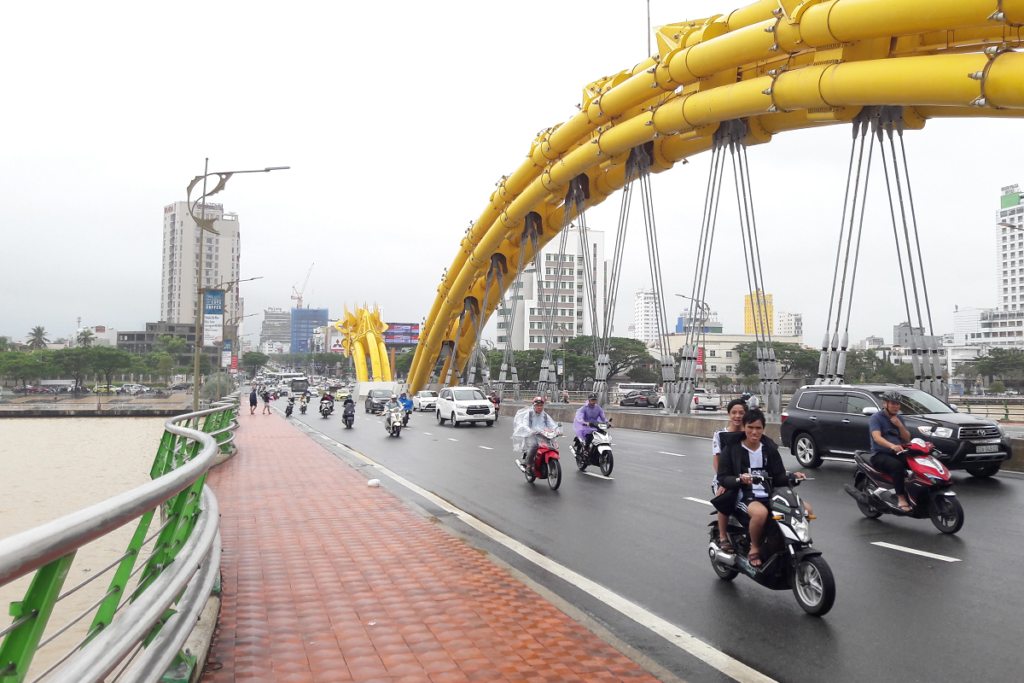
Table of content
- 1 Distance from Hoi An to Da Nang
- 2 Hoi An to Da Nang Airport (Hoi An Airport Transfer)
- 3 Bus From Hoi An to Da Nang
- 4 Hoi An to Da Nang by Taxi vs Private Car
- 5 How to Get From Hoi An to Ba Na Hills in Da Nang
- 6 How to Get From Hoi An to Golden Bridge in Da Nang
- 7 Hoi An to Da Nang’s Attractions by Motorbike
- 8 Hoi An to Da Nang Train Station (to Get Hue)
- 9 Hoi An to Da Nang in History
- 10 Related Posts
- 11 Bach Ma National Park: Hiking, Trekking in Da Nang and Hoi An
- 12 Hoi An Wet Season: What to Do in Hoi An When It Rains?
- 13 Thanh Ha Terracotta Park
- 14 Vinwonders Nam Hoi An Theme Park (formerly Vinpearl Nam Hoi An)
- 15 Am Phu Cave (Hell Cave) – Things to Do in Da Nang
- 16 Hoi An or Hue: Which is Better?
- 17 The Official Hoi An Travel Guide (MUST READ)
- 18 The Hoi An Market (Hoi An Central Market) Complete Guide
- 19 Hoi An Memories Show: The Best of Hoi An Impression Theme Park
- 20 Hoi An Bridge: Famous Bridges in Hoi An
- 21 How to Get From Hoi An to My Son Sanctuary
- 22 Hoi An’s Chinese Assembly Halls and Chinese Temples
- 23 Hoi An Walking Tours: Heritage, Foods, Photography & Locals
- 24 Hoi An Self Guided Walking Tour – Hoi An On Your Own
- 25 How to Visit Golden Bridge Vietnam
- 26 Unique Experiences in Hoi An and Why?
- 27 An Bang Beach: A Guide to Hoi An’s Best Beach
- 28 Experiences in Hoi An: Get Insight Into Hoi An’s Local Culture
- 29 Things to Do in Ba Na Hills Besides Golden Bridge
- 30 Hoi An Nightlife: What to Do in Hoi An At Night?
- 31 Hoi An Countryside: Villages, Rice Fields & Tours
- 32 How to Get to Golden Bridge From Hoi An
- 33 Hoi An Entrance Fee: Old Town, Golden Bridge, My Son, More
- 34 Hoi An Airport: Everything You Need to Know
- 35 Hoi An Lantern Boat Ride on Hoai River
- 36 Hoi An Private Car and Driver
- 37 What to Do in Hoi An Ancient Town
- 38 Da Nang and Hoi An Itinerary for Visitors Staying Overnight in Hoi An
- 39 Hoi An 3 Day Itinerary: A Travel Plan for 3 Days in Hoi An
- 40 Hoi An Free Things to Do: Budget Travel in Hoi An Vietnam
- 41 Hoi An One Day Itinerary: A Travel Plan for One Day in Hoi An
- 42 Hoi An Half-Day Tours: Guide to Half Day Trips From Hoi An
- 43 Hoi An Day Tours: A Guide to Best Day Trips From Hoi An
- 44 Hoi An Beach: A Guide to All Beaches in Hoi An Vietnam
- 45 Hoi An Food Specialties
- 46 How to Get From Hoi An to Da Nang
- 47 Hoi An Cheap Things to Do: All Solo Travelers Need to Know
- 48 Hoi An Best Things To Do: Recommendations from Local Experts
- 49 Hoi An Things to Do: All What Can You Do in Hoi An Vietnam
- 50 Hoi An Things Not to Miss: A Guide to Must Do in Hoi An
- 51 Hoi An or Da Nang: Which is Better for First Time Visitor?
- 52 Hoi An Pottery Village: A Guide to Thanh Ha Pottery Village
- 53 Hoi An Ancient Town Tour
- 54 Hoi An Old Town Ticket: Price, Sellers, Included Sites, More
- 55 My Son Sanctuary Tour
- 56 Hoi An Lanterns: Festival, Making Class, Where to Buy, More
- 57 Hoi An Best Area to Stay: Guide to Where to Stay in Hoi An
- 58 Hoi An Weather by Month: Guide to Hoi An Monthly Weather
- 59 Hoi An River Cruise: Guide to The Best Boat Tour in Hoi An
- 60 Hoi An Old Town Boats: Guide to Boat Rides in Hoi An Town
- 61 Hoi An 2 Day Itinerary: Traveler Guide to 2 Days in Hoi An
- 62 Cham Island Hoi An
- 63 Hoi An Basket Boat Ride
- 64 Hoi An Coconut Village: A Guide to Cam Thanh Coconut Village
- 65 Hoi An Cham Temples: My Son Sanctuary & Quang Nam Temples
- 66 How to Get from Da Nang Airport to Hoi An
- 67 Da Nang to Hoi An: Best Da Nang Airport Transfer and More
- 68 Hoi An Tour Guide: How to Find a Private Tour Guide in Hoi An
- 69 Hoi An Ancient Town Attractions
- 70 Hoi An Old Town Map
- 71 Tra Que Vegetable Village
- 72 Guide to Hoi An Lantern Festival – Hoi An Full Moon Festival
- 73 Hoi An Night Market: A Thing to Do in Hoi An at Night
- 74 My Son Sanctuary Travel Guide
- 75 Hoi An Old Town Unesco World Heritage – Hoi An Travel Guide
- 76 Featured Tours and Experiences
- 76.0.1 Bach Ma National Park Tour from Hue
- 76.0.2 Bach Ma National Park Tour from Da Nang/Hoi An
- 76.0.3 Hoi An Sunrise Fish Market Tour
- 76.0.4 My Lai Massacre Tour
- 76.0.5 Golden Bridge/Ba Na Hills & Hoi An Tour
- 76.0.6 Hoi An Instagram Tour
- 76.0.7 Ky Anh Tunnel & Tam Thanh Mural Village Tour
- 76.0.8 Da Nang to Hue Motorbike Tour with Hai Van Pass & Easy Rider (1 Way)
- 76.0.9 Hue to Da Nang Motorbike Tour with Hai Van Pass & Easy Ride (1 Way)
- 76.0.10 Hue to Hoi An Motorbike Tour with Hai Van Pass & Easy Rider (1 Way)
- 76.0.11 Hoi An to Hue Motorbike Tour with Hai Van Pass & Easy Rider (1 Way)
- 76.0.12 Tra Que Vegetable Village Tour with Cooking Class
- 76.0.13 Ba Na Hills Half Day Tour from Hoi An
- 76.0.14 Marble Mountain & Hoi An Day Tour from Da Nang Port
- 76.0.15 Hue Day Tour from Chan May Port with Lunch
- 76.0.16 Marble Mountain & Hoi An Tour from Chan May Port
- 76.0.17 Ba Na Hills/Golden Bridge Tour from Da Nang Port
- 76.0.18 Ba Na Hills/Golden Bridge Tour from Chan May Port
- 76.0.19 Golden Bridge Private Tour with Ba Na Hills & Lunch
- 76.0.20 Ba Na Hills Afternoon Tour with Golden Hands Bridge
- 76.0.21 Ba Na Hills Private Tour with Golden Hands Bridge
- 76.0.22 Ba Na Hills Half Day Tour with Golden Bridge
- 76.0.23 Ba Na Hills Early Morning Tour to Beat the Crowds
- 76.0.24 Golden Bridge and Ba Na Hills Night Tour
- 76.0.25 Golden Hands Bridge Tour In Sunrise or Sunset (1/2 Day)
- 76.0.26 Cam Kim Island Bicycle Tour From Hoi An
- 76.0.27 Cham Island Tour From Hoi An (Group Tour)
- 76.0.28 Cham Island Tour From Da Nang (Group Tour)
- 76.0.29 Hoi An Vegetarian Food Tour
- 76.0.30 Hoi An Evening Walking Food Tour with Local Foodie
- 76.0.31 Private Hoi An Basket Boat Tour (Shuttle Bus, Bicycle, Bike)
- 76.0.32 Half-day Am Phu Cave Tour (Private)
- 76.0.33 Hoi An Countryside Tour by Electric Car or Bike
- 76.0.34 Da Nang Tour Package From Singapore
- 76.0.35 Hoi An Evening Tour From Da Nang with Lantern Boat Ride
- 76.0.36 Hoi An Walking Food Tour Through Laneways
- 76.0.37 My Son Sanctuary and Hoi An Old Town Tour
- 76.0.38 My Son Day Trip From Hoi An including Marble Mountains and Basket Boat
- 76.0.39 Half Day Hoi An City Tour With River Cruise
- 76.0.40 Son Tra Peninsula Tour with Marble Mountains (Private/Small Group)
Distance from Hoi An to Da Nang
Hoi An city centre is the Old town world heritage and its surroundings, with a radius of 2 kilometers. The most central point is in the Hoi An Museum of History and Culture. Distance from it to the Dragon Bridge in Da Nang city’s core is 25 km and to the airport there is 27 km. If staying overnight in an accommodation at An Bang or Cua Dai beaches, the distances to Da Nang are 25 km and 28 km respectively. Of course, to get to the airport, travelers need to move further a couple of kilometers.
Da Nang is a large city, with many urban and rural districts. It has many famous attractions that travelers all want to see. These are distances from center of Hoi An to the most visited ones:
– Hoi An to Marble Mountains: 20 km
– Hoi An to Museum of Cham Sculpture: 27 km
– Hoi An to Ba Na Hills and Golden Bridge: 55 km
– Hoi An to Lady Buddha and Linh Ung Pagoda: 35 km
– Hoi An to Pink Church: 27,5 km
– Hoi An to Asia Park (Sun World Danang Wonders): 25 km
– Hoi An to My Khe Beach: 25 km
– Hoi An to Hai Van Pass: 55 km

Hoi An to Da Nang Airport (Hoi An Airport Transfer)
Location of Da Nang Airport
Hoi An’s nearest airport is in Da Nang’s downtown, 27 km northwest. It was established by the French and then used by Americans as a major air base in the Vietnam War (sometime busiest in the world). This Central Vietnam’s largest airfield served 15,5 millions of visitors in a recent year. Today, its facilities include 2 passenger terminals, the domestic and the international. Both of them are well connected with the rest of the city and Hoi An.
Travel Time from Hoi An to Da Nang Airport
Distance between Hoi An and Da Nang’s airport is 27 kilometers, via the shortest route. Meaning that it takes about 45 minutes if traveling by car and motorcycle riders for 1 hour.
Which is the Best Airport Transfer?
The best airport transfer from Hoi An to Da Nang is by private car. It should be booked on a dependable online site and provider. The reasons are its more affordable price than taxi, flexible departure times, suitability for small groups and families and comfort in any weather. Especially if you have heavy luggages and many souvenirs, it’s perfect to carry them with the passengers. Travel time is 45 minutes and shorter when starting in the early morning or late night. During the rainy season, a car is the best fit. The price of a four-seat car ranges from 200,000 to 350,000 VND depending on different times of the day and the year.
Text us in whatsapp number +84968009287 if you need a reasonably-priced private car transfer from your hotel to Da Nang airport.
Bus From Hoi An to Da Nang
The Bus and Hoi An Bus Station
Featuring a yellow color, Bus 1 is the only public bus from Hoi An to Da Nang. During the day, there are about 2 buses parked in the Hoi An Bus Station to serve the cheapest ride between cities. The terminal is at Le Hong Phong St, 1,5 km from the iconic Japanese Bridge, 4,5 km from An Bang beach and 6 km from Cua Dai beach. If staying in the city center, it’s possible to get there by foot and in further areas, a short taxi ride is needed.
Reschedule and Ticket of Hoi An to Da Nang Bus
Bus from Hoi An to Da Nang runs from 5:30 a.m to 5:50 p.m daily, with a frequency of 30 minutes. Travelers are advised to be in the bus station at least 5 minutes before the departure times. Parking is available just nearby, with a fee of 5,000 VND for bicycles. Passengers will pay 20,000 VND and this price covers the whole itinerary (from Hoi An bus station to Da Nang bus station). No matter where they get off, it’s unchanged. If traveling by luggages, the bus attendant may charge an extra 10,000 VND. Preparing small cash in VND in advance to avoid wrong exchange from him/her, keep in mind.
After leaving the station, Hoi An to Da Nang bus moves along Nguyen Tat Thanh and DT607 roads before Da Nang. It picks up and drops off randomly in this part, meaning that if someone hails, the rider will pull over and allow him/her to get on (and vice versa). Then, it stops in regulated stations along Le Van Hien, Ngu Hanh Son, 2 Thang 9, Bach Dang, Hung Vuong, Ong Ich Khiem, Nguyen Tat Thanh roads and others. The final one is the Da Nang Bus Station where the passengers can find buses to anywhere across the country.
The whole ride is over 1 hour. Therefore should time well your plan to feel more relaxed if aiming to get another bus to somewhere, like Hue.
Sightseeing Places in and near the Bus Itinerary
– The Marble Mountains: around 30 mins after leaving the bus station. The bus will drop off passengers near the crossroad Huyen Tran Cong Chua – Le Van Hien. To see ticket counters and entrances, walk along H.T.C.Chua St and all roads leading up to the mountain are to the left. Entry fee is 40,000 VND and it’s free in 2022.
– Museum of Cham Sculpture: the bus will stop at some places before this museum and after crossing the Han River. Travelers will see the largest collection of sandstone sculptures carved by Cham people prior to the fall of their kingdom in 19th century. Entry fee is 60,000 VND and it’s free in 2022.
– Dragon Bridge: to visit this unique bridge, get off in the same station to Cham Museum, it’s just a few walks from there. The head of the dragon is on the opposite bank.
– Han Market: After the Cham Museum, the bus will stop at points along the Han riverfront Bach Dang including this market.
– Da Nang Cathedral: stop at the Han market and then take a short walk. Its entrance is in Nguyen Thai Hoc (back gate), not in Tran Phu St, free to visit.
– Con Market: dropping off points in both Hung Vuong and Ong Ich Khiem roads are near this traditional market. Travelers can shop and eat local foods at a local price here.
Getting to Da Nang’s Main Transport Hubs
Traveling by Bus 1 is a cheap method to get to major transport hubs in Da Nang from Hoi An. After getting off, the passengers often need to have a short walk or transfer by another vehicle. Sure, it’s free or inexpensive. The best way for each hub is outlined in brief as following below:
– International terminal of Da Nang airport: leave the bus in the Cham Museum and then take a taxi (around 2 km)
– Domestic terminal of Da Nang airport: leave the bus in the left bank of Tran Thi Ly bridge (after cross the river) and then take a taxi transfer for 2 km
– Da Nang train station: leave the bus in Ong Ich Khiem St and then walk along Hai Phong St, don’t need a taxi ride
– Da Nang central bus station: the last stop, so just enjoy watching the city until the bus arrives here. It’s easy to see a bus to go to Hue after.
Hoi An to Da Nang by Taxi vs Private Car
Getting a taxi is the easiest way to get from Hoi An to Da Nang. In the hotel, travelers can ask for help from receptionists, they definitely do. At luxury and famous places, there are some cabbies always available outside. Cost of a local-brand taxi is metered, ranging from 13,000 to 16,000 VND for each kilometer, depending on length of the drive. If traveling around the city and to a distance of 30 km, the cost is the same and it’s lower when getting somewhere further. Larger cars charge more than smaller ones. Therefore, a ride from Hoi An to Da Nang center by four-seat taxi is from 300,000 to 400,000 VND. It’s cheaper if travelers contact taxi firms in advance and have a contract.
Private cars are another popular way to transport between cities. Travelers can find and book in so many places, both online and offline. In common, the price of a four-seat car from Hoi An to Da Nang center and airport, is from 200,000 to 350,000 VND. It may be cheaper in low seasons and in promotions (especially on the internet). To select the best deal for yourself, you should ask a couple of sellers before booking such as the hotel, reliable online sites, tour operators near you. The ride is not long (45 mins to 1h), so the quality is quite the same between providers.
How to Get From Hoi An to Ba Na Hills in Da Nang
Ba Na Hills is a reputable entertainment complex in the top of Da Nang, at an elevation of nearly 1,500 meters. It’s widely known for cool weather all year round, world-record cable car network, breathtaking sceneries and exciting activities. In 2018, the Golden Bridge was opened and soon became a social media hit. Later, many magazines named it in the list of places to visit once in your lifetime. Ba Na Hills is a perfect place for a day trip outside of Hoi An. During the hottest or busiest times of the year, travelers are advised to depart in early morning or late afternoon.
The shortest distance from Hoi An to Ba Na Hills’s cable car terminal is about 55 km. It takes over 1 hour if traveling by car or bus and 1,5 hours for motorcycle riders. Getting there by yourself is not hard and quite cheap. No matter if you would like to join a tour or get free in a personalized plan, you should read details in How to Get from Hoi An to Ba Na Hills to know necessary information.
How to Get From Hoi An to Golden Bridge in Da Nang
The Golden Bridge (Cầu Vàng) is one of the world’s wonders in Vietnam. It’s located in the highest mountain of Da Nang, called Nui Chua, at an elevation of 1,414 meters. This inspirational, amazing building features a pedestrian walkway with gold-plated handrails that holded by two giant hands. The designers shared that it represents a string of silk that the Gold of Mountain wants to give to visitors worldwide. Now, the Golden Hand Bridge is the most famous of its kind in the city and the country.
The bridge is accessible by car and cable car, but tourists are allowed to the second only due to safety reasons. It takes around 17 minutes to get from the mountain foot to its nearest cable car station. See details in our guide for both self guided and guided travelers in Da Nang Golden Bridge Tour.
Hoi An to Da Nang’s Attractions by Motorbike
Motorbike Rental in Hoi An
It’s easy to rent a motorcycle in Hoi An. Possible places are hotels, local shops near the hotel and online sites including tour agencies. The price for one day rental of a semi-automatic bike is from 100,000 to 150,000 VND, and is more expensive if like to ride an automatic bike. Fuel is always not covered by these costs, but absolutely it’s cheap. A motorcycle can be shared for two people and the one in the front needs to have a driver license and an IDP (internal driving permit).
Getting to Da Nang’s Attractions and Parkings
There are many stunning places in Da Nang that travelers should not miss out on if have time. The best for motorcyclists is Hai Van Pass – a coast road with spectacular scenery and numerous hairpin turns, and then Son Tra Mountain or peninsula with off-the-beaten-path routes and beautiful outlooks. Riding around the city to see its iconic landmarks and local food markets is also popular. Parking fee is around 5,000 VND at most places. The coolest drives are along the riverfronts and seafronts.
Hoi An to Da Nang Train Station (to Get Hue)
Da Nang train station is in Hai Phong St, in the center of Da Nang. It’s 30 km away from Hoi An, therefore the travel time is around 45 minutes by car or taxi. If getting there by Bus 1 (public), the drive may be one hour. Travelers should get off at a station in Ong Ich Khiem St, to minimize the distance to the station. The ticket costs 20,000 VND only, so definitely the bus is the cheapest. Read more information in Hoi An to Hue.
Read also: Da Nang Railway Station, Da Nang to Hue by Train
Hoi An to Da Nang in History
Boat from Hoi An to Da Nang
Da Nang and Hoi An are connected with De Vong river, flowing from Han river in Da Nang and into the larger Thu Bon river near its estuary. When Hoi An was an international trading port, this waterway was also busy by boats carrying cargo. In 1835, Minh Mang – the 2nd king of Hue-based Nguyen dynasty requested all foreign boats to stop only in Da Nang’s harbour. The decision was one of the reasons for the decline in commerce of Hoi An at the time. Over the years, Da Nang replaced its role and became a leading regional commercial center. On the other hand, the river was partially covered by sand and so did not support traffic anymore. In the near future, it will be dredged to make things alive and grow tourism.
Read also: Hoi An river cruise, Da Nang boat trips
Hoi An to Da Nang by Train
In 1888, Da Nang became a French concession and the colonists gave the name “Tourane” to it. Quickly after, many state-of-the-art buildings were built in this area, including grid-like streets, hospitals, markets, post office, church, and especially a city train network. Many industries are also birthed and developed, making Da Nang soon turned into an important urbans in the country (although very young). In the 1890s, the busiest route to Hoi An – Co Co river partially got stucked” by sand. To keep the wealth of trade, in 1902, French businessmans requested to construct a railway and 3 years later, it came to reality. Every day, the train run three times, 2 in the morning and one in the afternoon. However, sand once again was the problem and many parts of the track were covered, making the transportation impossible in long hours. Traffic got lower after that due to a significant decrease of profits in Hoi An. The intention of abandoning the railway reached its peak in 1916 when a typhoon hit the area and damaged many things. French din’t use it anymore in the next year.
Read also: Da Nang to Hue by train (Hai Van Pass train)
Related Posts
Bach Ma National Park: Hiking, Trekking in Da Nang and Hoi An
Two best places for trekking and hiking in and near Da Nang are Son Tra mountain (peninsula) and Bach Ma national park. Which one is better is actually personal because these
Hoi An Wet Season: What to Do in Hoi An When It Rains?
No beach, no pool, no outdoor adventures? What to do in Hoi An when it rains? This is a very popular question from travelers who come to Vietnam in the
Thanh Ha Terracotta Park
Between 15th and 19th centuries, Hoi An was one of major stopovers for sailing merchants to trade in Southeast Asia. Meanwhile, craftspeople in its Thanh Ha village produce high-quality pottery
Vinwonders Nam Hoi An Theme Park (formerly Vinpearl Nam Hoi An)
In addition to historical and cultural attractions, nowadays Hoi An also has a couple of amusement parks to entertain. Definitely, they’re ideal places for families with children and groups of
Am Phu Cave (Hell Cave) – Things to Do in Da Nang
Although in the Marble mountains – the most visited attraction in Da Nang, travelers often miss Am Phu cave. One of reasons is that it’s mentioned much online and not
Hoi An or Hue: Which is Better?
Both Hoi An and Hue cities are in the middle of Vietnam, and they’re not far from each other (about 130 km). Therefore, for those who travel from north to
The Official Hoi An Travel Guide (MUST READ)
By the estuary of Thu Bon river, Hoi An is one of the best places to visit in Vietnam. This Vietnamese town is a package for travelers – a pretty
The Hoi An Market (Hoi An Central Market) Complete Guide
The Hoi An Market is the first market in Hoi An ever. Over centuries, it’s still the largest market in town although the town has a much bigger size than
Hoi An Memories Show: The Best of Hoi An Impression Theme Park
The Hoi An Memories Show is a famous series of outdoor performances in Hoi An at the present time. Thanks to its exceptional production and great cultural stories, it becomes
Hoi An Bridge: Famous Bridges in Hoi An
Hoi An has many bridges because it’s located at the confluence of 3 rivers: Thu Bon river, De Vong river and Truong Giang “Long river”. The distributaries of these rivers
How to Get From Hoi An to My Son Sanctuary
My Son sanctuary is one of the most popular places to visit for tourists staying overnight in Hoi An, especially those who spend many days there. It’s known for a
Hoi An’s Chinese Assembly Halls and Chinese Temples
Chinese people migrated to Hoi An from the early 17th century. Today, Chinese communities as a whole are the second most important piece to form the town’s unique culture. The foremost
Hoi An Walking Tours: Heritage, Foods, Photography & Locals
Strolling around heritage quarters with a local guide is the activity that so many travelers love to do in Hoi An. It enriches their time in this lovely town. Firstly,
Hoi An Self Guided Walking Tour – Hoi An On Your Own
Hoi An old town is friendly for pedestrians, especially during the time that motorized vehicles (scooters, cars, etc) are prohibited to move around its heritage quarters. That is safe for
How to Visit Golden Bridge Vietnam
The Golden Hand Bridge of Ba Na hills today is a dream place to visit for many travelers. Since it opened in June 2018, millions of people have set their
Unique Experiences in Hoi An and Why?
Today, travelers seek more experiences in the destination they go to. They want to have a deeper understanding about the culture of local people and interact with them. No other
An Bang Beach: A Guide to Hoi An’s Best Beach
An Bang beach now becomes a popular tourist attraction in Hoi An. It may be the best known and most convenient to reach from the town’s centre. Not only tourists,
Experiences in Hoi An: Get Insight Into Hoi An’s Local Culture
As the most unique Vietnamese town, Hoi An is definitely worth visiting. Here, visitors have many things to do and experiences for their holiday time. Everyone knows that it has
Things to Do in Ba Na Hills Besides Golden Bridge
According to local authorities, 50% of visitors coming to Da Nang and Hoi An visit the Ba Na hills. In other words, that is nearly 10 millions of people. This
Hoi An Nightlife: What to Do in Hoi An At Night?
After dark, Hoi An becomes exceptionally spectacular. If planning to stay overnight or visiting this ancient heritage town, at least travelers know that it’s “decorated” by so many colorful lanterns.
Hoi An Countryside: Villages, Rice Fields & Tours
By the coast, Hoi An is at the confluence of 3 rivers: Thu Bon river, Truong Giang river and De Vong river. This economically strategic location has supported trading activities
How to Get to Golden Bridge From Hoi An
There are many travelers visiting the Golden bridge from Hoi An. Both the bridge and the town today are must-see places in the region, so staying overnight in the town
Hoi An Entrance Fee: Old Town, Golden Bridge, My Son, More
Are you planning to visit Hoi An? And you don’t know how much cash you need to prepare for visiting places? This article lists tourist attractions in Hoi An and
Hoi An Airport: Everything You Need to Know
Hoi An is a famous tourist city in Vietnam. It’s 800 kilometers away from Hanoi, the capital of Vietnam and nearly 1,000 kilometers from Ho Chi Minh city, the biggest
Hoi An Lantern Boat Ride on Hoai River
A lantern boat ride is a thing to do that visitors must do today in Hoi An. For many centuries, locals have taken it on the Hoai river by the
Hoi An Private Car and Driver
Hoi An is one of the most popular tourist destinations in Vietnam. In the busiest year, it attracts about 9 millions visitors who come to enjoy its charming beauty, rich
What to Do in Hoi An Ancient Town
Hoi An Ancient Town is a must see, not only thanks to its world heritage title, but also to its vintage urban landscape, lots of attractions and activities. In the
Da Nang and Hoi An Itinerary for Visitors Staying Overnight in Hoi An
Da Nang and Hoi An are twin cities in the heart of Central Vietnam. Both are popular tourist destinations for either domestic or international visitors, and share many similarities. Due
Hoi An 3 Day Itinerary: A Travel Plan for 3 Days in Hoi An
3 days are a perfect duration to stay overnight in Hoi An and explore captivating places in and around it. Especially for those who travel from city to city or
Hoi An Free Things to Do: Budget Travel in Hoi An Vietnam
Travelers should know free things to do in Hoi An, to save the budget for this wonderful city and by that, can stay longer to explore. From old town, countryside
Hoi An One Day Itinerary: A Travel Plan for One Day in Hoi An
From a backwater town in the 1990s, Hoi An today is one of leading tourist destinations across Vietnam. In a recent year, it attracted 8,5 millions of overnight visitors and
Hoi An Half-Day Tours: Guide to Half Day Trips From Hoi An
Top attractions near Hoi An require a couple of hours or half a day, to get there and visit around. The reason is that all have many things to see,
Hoi An Day Tours: A Guide to Best Day Trips From Hoi An
Near Hoi An, there are many fantastic places making travelers can’t stay in the room and have to go out to explore. Appeal Golden bridge – the new world wonder,
Hoi An Beach: A Guide to All Beaches in Hoi An Vietnam
Not only an old town, Hoi An has beaches as well! That are sandy, edged by tropical water and lined by palm forests. Travelers don’t need to wait or move
Hoi An Food Specialties
Hoi An is a melting pot where people from different parts of Vietnam and countries in the world have gathered and exchanged their cultures. As a result, this town has
How to Get From Hoi An to Da Nang
Da Nang is the neighbouring city of Hoi An. It's the capital of Central Vietnam and has the most important (busiest) transport hubs of the region, such as airport, train
Hoi An Cheap Things to Do: All Solo Travelers Need to Know
Knowing free and cheap things to do in the city where travelers are going to visit, is helpful. First of all, they can save and, thanks to that, can stretch
Hoi An Best Things To Do: Recommendations from Local Experts
It is no coincidence that Hoi An is in the list of must-visit places once in the lifetime of many travelers. Located by a river, it’s borned to welcome people
Hoi An Things to Do: All What Can You Do in Hoi An Vietnam
Hoi An is in the bucket list of most travellers who plan to visit the Central part of Vietnam. It’s a lovely old and small town located downstream of a
Hoi An Things Not to Miss: A Guide to Must Do in Hoi An
In fact, there are so many things to do in Hoi An, one of the 10 best cities in Asia by Travel + Leisure in 2021. It has a lantern-filled
Hoi An or Da Nang: Which is Better for First Time Visitor?
Da Nang and Hoi An are located in Central Vietnam, with a distance of roughly 30 km. To the north, Da Nang is the capital city of the region, with
Hoi An Pottery Village: A Guide to Thanh Ha Pottery Village
Hoi An used to be a bustling, prosperous trade port during past centuries, before its role was replaced by Da Nang. Merchants from many countries on different continents came here
Hoi An Ancient Town Tour
Hoi An Ancient Town is a Unesco world heritage site by the mouth of the Thu Bon River. It has grid-plan streets filled by silk lanterns and bougainvillea flowers that
Hoi An Old Town Ticket: Price, Sellers, Included Sites, More
As an attraction including attractions, Hoi An Old Town requires an entrance ticket to tourists who come from other parts of Vietnam and the world. It raises funds for preservation of
My Son Sanctuary Tour
My Son Sanctuary is a Unesco world heritage site, attracting 450,000 visitors in recent years. It’s the best remains left by the fallen Champa Kingdom which ruled a part of
Hoi An Lanterns: Festival, Making Class, Where to Buy, More
Lanterns are the signature of Hoi An Old Town, the 3rd Unesco world heritage site in Vietnam. Especially at night, these traditional handicraft objects are lit up and make the town
Hoi An Best Area to Stay: Guide to Where to Stay in Hoi An
In the busiest year, nearly 5,5 millions travellers decided to stay overnight in Hoi An. It’s the largest number that a city in the Central coast of Vietnam ever achieved.
Hoi An Weather by Month: Guide to Hoi An Monthly Weather
Hoi An won the title “Asia’s leading cultural destination” recently in a reputable global travel award. It’s a pretty riverine-coastal town with an ancient root, surrounded by peaceful pieces of
Hoi An River Cruise: Guide to The Best Boat Tour in Hoi An
Hoi An town is by the left bank of the Thu Bon River, and by that, it draws plenty of merchants by sailing boat to visit and trade. Its golden
Hoi An Old Town Boats: Guide to Boat Rides in Hoi An Town
Hoi An town sits by the left bank of the Thu Bon River, the largest and most important waterway in mother Quang Nam province. It’s also near the mouth of
Hoi An 2 Day Itinerary: Traveler Guide to 2 Days in Hoi An
2 days are enough to know the highlights in Hoi An, a famous tourist destination in Central Vietnam. And for those who travel from city to city, 48 hours are
Cham Island Hoi An
The purple islands seen from An Bang or Cua Dai beaches are the Cham Islands. It’s one of the kind in the region where God bless it with fabulous beautiful
Hoi An Basket Boat Ride
Nowhere else outside of Hoi An Coconut Village, travelers can find a basket boat ride across the immense palm forests. It’s an experience that allows the passengers to know better
Hoi An Coconut Village: A Guide to Cam Thanh Coconut Village
Hoi An Coconut Village boasts of the most interlaced waterway system in the city. Four rivers encircle it and are connected together with smaller canals. Thanks to fertile alluvia and
Hoi An Cham Temples: My Son Sanctuary & Quang Nam Temples
Cham people settled in Hoi An before the Vietnamese arrived and handed it over in 14th century. Influenced by Indian culture, they called the land “Amaravati”, similar name to a
How to Get from Da Nang Airport to Hoi An
Located in the city of the same name, Da Nang airport is the nearest airport to Hoi An. So, if travelers want to see an extremely-colorful Lantern festival or try
Da Nang to Hoi An: Best Da Nang Airport Transfer and More
If traveling to Hoi An by air, train and cruise ship, visitors will come to Da Nang first and then have a transfer. The largest city of Central Vietnam holds
Hoi An Tour Guide: How to Find a Private Tour Guide in Hoi An
Most tour packages in Hoi An cover “ a guide”. He or she may be the first and closest local to the visitors, who lead the group to enjoy the
Hoi An Ancient Town Attractions
Spreading over an area of 30 hectares, Hoi An Old Town owns more than 1,100 timber buildings varying in function or type. In the oldest street, the Japanese bridge spans
Hoi An Old Town Map
There are so many things to see, do, eat and sleep in Hoi An Old Town, so the visitors often are confused while planning and exploring. Starting the research from
Tra Que Vegetable Village
Located in a prime location between two famous attractions, the Old Town and An Bang beach, Tra Que vegetable village is a featured point of interest. It’s famous for vegetable
Guide to Hoi An Lantern Festival – Hoi An Full Moon Festival
The Lantern Festival is amongst the best times to visit Hoi An. In which, visitors will immerse themselves in a shimmering world of uncounted lantern lights. When the crowds fill
Hoi An Night Market: A Thing to Do in Hoi An at Night
One of the most visited attractions in Hoi An is its night market. Because it is located right near the Old town, first-timer travelers commonly explore both top sights in
My Son Sanctuary Travel Guide
My Son Sanctuary is a complex of Hindu temples and a Unesco world heritage site from 1999. It’s 40 km away from Hoi An and 70 km to the southwest
Hoi An Old Town Unesco World Heritage – Hoi An Travel Guide
Situated 30km south of Da Nang, Hoi An ancient town is one of the best attractions in Central Vietnam. It is titled as the prettiest town of the country and
